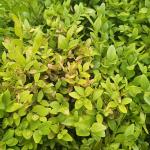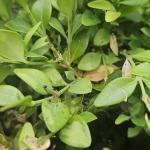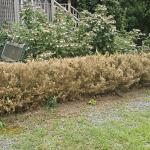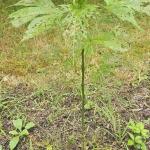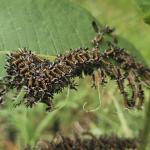UMass Extension's Landscape Message is an educational newsletter intended to inform and guide Massachusetts land care professionals in the management of our collective landscape. Detailed reports from scouts and Extension specialists on growing conditions, pest activity, and cultural practices for the management of woody ornamentals, trees, and turf are regular features. The following issue has been updated to provide timely management information and the latest regional news and environmental data.
Welcome to Landscape Message #14 for the 2024 growing season. We are now in the bi-weekly phase of the annual schedule, and the next message will be posted August 9. To receive immediate notification when the next Landscape Message update is posted, be sure to join our e-mail list
Click on the headings below to jump to that section of the message.
In This Issue
Scouting Information by Region
Woody Ornamentals
Scouting Information by Region
Environmental Data
The following data was collected on or about July 24, 2024. Total accumulated growing degree days (GDD) represent the heating units above a 50ºF baseline temperature collected via regional NEWA stations (http://newa.cornell.edu) for the 2024 calendar year. This information is intended for use as a guide for monitoring the developmental stages of pests in your location and planning management strategies accordingly.
|
MA Region/Location |
2024 Growing Degree Days |
Soil Temp |
Precipitation |
Time/Date of Readings |
||
| Gain since last report |
2024 total |
Sun |
Shade |
|||
|
CAPE |
408 |
1429 |
72 |
69 |
1.26 |
12:00 PM 7/24/2024 |
|
SOUTHEAST |
416 |
1641 |
74 |
63 |
0.62 |
3:00 PM 7/24/2024 |
|
NORTH SHORE |
392 |
1480 |
72 |
66 |
0.46 |
10:00 AM 7/24/2024 |
|
EAST |
410 |
1663 |
74 |
67 |
0.63 |
4:00 PM 7/24/2024 |
|
METRO |
381 |
1582 |
72 |
68 |
0.85 |
5:30 AM 7/24/2024 |
|
CENTRAL |
384 |
1596 |
72 |
70 |
0.70 |
8:00 AM 7/24/2024 |
|
PIONEER VALLEY |
377 |
1638 |
77 |
70 |
2.87 |
3:00 PM 7/23/2024 |
|
BERKSHIRES |
334 |
1429 |
74 |
68 |
2.04 |
7:00 AM 7/24/2024 |
|
AVERAGE |
388 |
1557 |
73 |
68 |
1.18 |
- |
|
n/a = information not available |
||||||
US Drought Monitor: Improvement on the drought front for this message. At this time, just small sections of northern Berkshire and Franklin counties, northern Middlesex county, and the northern 2/3 of Essex county are classified as "D0 - Abnormally Dry" (about 9% of the state's area in total). State map as of Thursday 7/25: https://droughtmonitor.unl.edu/CurrentMap/StateDroughtMonitor.aspx?MA
Phenology
| Indicator Plants - Stages of Flowering (BEGIN, BEGIN/FULL, FULL, FULL/END, END) | ||||||||
|---|---|---|---|---|---|---|---|---|
| PLANT NAME (Botanic / Common) | CAPE | S.E. | N.S. | EAST | METRO W. | CENT. | P.V. | BERK. |
|
Polygonum cuspidatum (Japanese knotweed) |
* |
Begin |
* |
* |
* |
* |
* |
* |
|
Clethra alnifolia (summersweet clethra) |
Begin |
Begin |
Begin |
Begin |
Begin/Full |
Begin |
Begin/Full |
Begin/Full |
|
Hibiscus syriacus (rose-of-Sharon) |
Begin |
Full |
Full |
Full |
Begin/Full |
Begin |
Full |
Full |
|
Buddleia davidii (butterfly bush) |
Begin/Full |
* |
Full |
Full |
Full |
Full |
Full |
Full |
|
Lythrum salicaria (loosestrife) |
Full |
Full |
Full |
Full |
Full |
Full |
Full |
Full |
|
Campsis radicans (trumpet vine) |
Full |
Full/End |
Full |
Full |
Full |
Full |
Full |
Full |
| * = no activity to report/information not available | ||||||||
Regional Notes
Cape Cod Region (Barnstable)
General Conditions:
The average temperature for the period from July 10 thru July 24 was 76ºF with a high of 90ºF on July 16 and a low of 64ºF on July 19. Most of the period was dominated by days with highs in the 80s and lows in the 70s, ending on a couple of days of cooler weather. An inch and a quarter of precipitation was recorded for the period in Barnstable, with most occurring on July 13. Soil moisture is short. Unirrigated lawns are dormant.
Herbaceous plants seen in bloom include purple cone flower (Echinacea purpurea), black eyed susan (Rudbeckia hirta), Russian sage (Salvia yangii), daylily (Hemerocallis spp.), balloon flower (Platycodon grandiflorus), and bee balm (Monarda spp.). Woody plants seen in bloom include sourwood (Oxydendrum arboreum), hydrangea (H. macrophylla, H. paniculata, and H. quercifolia), mimosa (Albizia julibrissin), and abelia (Abelia x grandiflora).
Pests/Problems:
Box tree moth caterpillars are actively feeding on boxwood. Boxwood should be scouted regularly for this pest; if left unmanaged box tree moth caterpillars defoliate and kill boxwood.
Insects or insect damage observed during the period include pine tip moth damage on pitch pine; hibiscus sawfly damage and larvae on hibiscus; fall webworm on holly; Japanese beetle damage on numerous plants; Oriental and Asiatic beetle activity; leafminer damage on cleome, aquilegia, and daylily; strawberry leaf roller damage to bearberry; hemlock woolly adelgid on hemlock; eyespot gall on tuliptree; euonymus scale on Japanese holly; gladiolus thrips on gladiola; and leafhopper damage to dahlia.
Disease symptoms or signs observed during the period include powdery mildew on many woody and herbaceous plants, venturia leaf spot on poplar, cedar apple rust on crabapple, pear trellis rust on Bradford pear, daylily leaf streak on daylily, cercospora leaf spot on bigleaf hydrangea, and septoria leaf spot on Rudbeckia. Foliar nematode damage was also observed on Astrantia and hosta.
Weeds seen in bloom include fleabane (Erigeron annuus), chicory (Cichorium intybus), and spotted knapweed (Centaurea stoebe).
Southeast Region (Dighton)
General Conditions:
Over the past two weeks, since Wednesday, July 10th, we've had typical summer conditions with tropical, hot and humid days. The highest temperature was 91ºF on Monday, July 15th, while the lowest was 61ºF on the morning of the following Tuesday. The average was approximately 76ºF. There were rain showers on Thursday, July 11th, Saturday, July 13th, Thursday, July 18th, Tuesday, July 23rd and Wednesday, July 24th, although the accumulation was slight, totaling 0.62 inches. However, humidity was consistently high, averaging around 81%, particularly during early mornings and late evenings, producing localized fog and morning dew. The highest wind was 17 mph from the south-southwest on Wednesday, July 17th. On July 24th at 3 PM, the soil temperature in full sun was 74ºF and in shade was 63ºF.
Among the plants in flower are Campsis radicans (trumpet vine), Clethra alnifolia (summersweet clethra), Hibiscus syriacus (rose-of-Sharon), Hydrangea paniculata (panicle hydrangea), Koelreuteria paniculata (goldenrain tree), Lythrum salicaria (loosestrife), and Vitex agnus-castus (chastetree).
Pests/Problems:
The extended heat has pushed many plants into early fall senescence and drought dormancy. Stressed red and sugar maples as well as burning bush are beginning to color. Yellow nutsedge is flowering. Bagworm defoliation of arborvitae is prevalent throughout the region.
North Shore (Beverly)
General Conditions:
This two-week reporting period was hot and humid except for a few days towards the end when there were cloudy and overcast skies along with scattered rain showers and cooler temperatures. Temperatures above 90º were recorded on four days during this period. A heat wave came through July 15 through the 16th with temperatures in the low 90s and high humidity. Nighttime temperatures during the heatwave were also relatively high, in the low-70s. The average daily temperature for this reporting period was 76ºF with the maximum temperature of 94ºF recorded on July 16 and the minimum temperature of 59ºF recorded on July 22. The few rain showers received during this period were very light, totaling to less an inch of rainfall during the two-week period... approximately 0.46 inch of rainfall was recorded at Long Hill.
Woody plants seen in bloom include, sourwood (Oxydendrum arboreum), silk tree or mimosa (Albizia julibrissin), bottlebrush buckeye (Aesculus parviflora), smooth leaf hydrangea (Hydrangea arborescens), false spirea (Sorbaria arborea), Chinese chaste tree (Vitex sinensis), trumpet vine (Campsis radicans), and rose-of-Sharon (Hibiscus syriacus). Herbaceous plants seen in bloom include, day lily (Hemerocallis spp), coneflower (Echinacea purpurea), black eyed susan (Rudbeckia spp), bee balm (Monarda didyma), milkweed (Asclepias syriaca), shasta daisy (Leucanthemum x superbum), yarrow (Achillea millefolium), garden phlox (Phlox paniculata), hostas (Hosta spp), sedums (Sedum spp), Stachys (Stachys officinalis), summer flowering roses (Rosa spp.), clematis vines (Clematis paniculata), spiderwort (Tradescantia spp.), Persicaria (Persicaria polymorpha), water lily (Nymphaea odorata), and an assortment of annuals.
Pests/Problems:
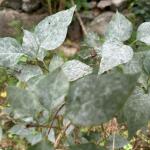
 Powdery mildew was observed on susceptible lilac varieties and on garden phlox.
Powdery mildew was observed on susceptible lilac varieties and on garden phlox.
Japanese beetle damage was observed on some plants.
Rabbits are plentiful this year and causing damage to some annual and vegetable plants.
Crabgrass, yellow nutsedge, and other weeds are thriving due to the hot temperatures and precipitation.
Ticks and mosquitoes are very active. Protect yourself with an effective insect repellent before going out to the landscape and check your body for ticks after you return.
East (Boston)
General Conditions:
It has been hot and humid. We had temperatures in the 90’s on five of the past 14 days. Daytime temperatures averaged 87ºF with a high of 95ºF on July 16th. From July 10th through the 18th overnight lows never fell below 70ºF. The threat of thunder showers consistently bypassed the region. We have received only 0.63 inches of precipitation over the past two weeks. We have reached 1619 growing degree days (base 50).
Perennial borders and meadows continue to add color to the landscape and are busy with pollinator activity.
Pests/Problems:
Minimal rainfall and consistent high temperatures are drying out many soils. Recent transplants, without supplemental irrigation, are showing signs of stress.
Viburnum leaf beetle (Pyrrhalta viburni) adults are defoliating susceptible Viburnum and laying eggs on the twigs. The squash vine borer (Melittia cucurbitae) is in the larval stage and tunneling inside the stems of pumpkin, yellow squash and zucchini plants. Wilting and branch dieback on a group of Viburnum trilobum (American cranberry-bush) was attributed to Botryosphaeria canker on the drought stressed Viburnums. Wilting and dieback on a two-year-old healthy planting of Rhus aromatica (fragrant sumac) is likely fusarium wilt, caused by the soil born fungi Fusarium oxysporum.
An observation, not a threat to plant health; the white foamy substance on the leaf axils of Cornus sericea (red twig dogwood) is evidence of the dogwood spittle bug (Clastroptera proteus) nymph feeding.
Metro West (Acton)
General Conditions:
We are in the full swing of summer. During this two-week reporting period this area completed its second heat wave of the summer with a 5-day run beginning on July 7th and ending on the 11th with temps recorded at 91º, 93º, 91º, 91º, and 91º. A third heat wave on July 15th, 16th, and 17th featured temperatures recorded at 93º, 93º, and 91º respectively. For July, the historical monthly average precipitation is 4.07”. As of the 23rd, 1.82” of rain has been recorded for this area. Overall, there have been 11 days this summer with temperatures recorded in the 90s and 8 of those days occurred in July and the other 3 in June.
The landscape is lush and colorful with all that is in some stage of bloom including the following plants: Albizia julibrissin (silk tree), Cichorium intybus (chicory), Clethra alnifolia (summersweet), Eutrochium purpureum (Joe Pye weed), Hibiscus syriacus (rose-of-Sharon), Phlox carolina (Carolina phlox), P. paniculata (garden phlox), Perovskia atriplicifolia (Russian sage), Senna marilandica (wild senna), and Verbena hastata (American blue vervain).
Pests/Problems:
Setting seed and quite visible is Ailanthus altissima (tree of heaven), an invasive tree that is now highly visible and showy because its seeds (samaras) are reddish in color, are plentiful and grow in large clusters. Look for it growing along roadsides and in parking lots and medians.
Observed in the landscape this past two weeks were leaf blotch on Aesculus sp. (horsechestnut) and cedar apple rust on Amelanchier sp. (serviceberry).
Central Region (Boylston)
General Conditions:
Though temperatures have continued to stay high, we are starting to see the first glimpse of cooler summer nights. With temperatures averaging 83.7ºF (highest being 89.6F on the 17th), nights have dropped as low as 61.9ºF. Max precipitation was 0.49 inches on the 17th, leaving some days to follow with saturated soils but then soon to dry out again.
Some plants that can be seen blooming currently are hydrangeas (Hydrangea spp.), bottlebrush buckeye (Aesculus parviflora), coneflower (Echinacea spp.), great lobelia (Lobelia siphilitica), mountain mint (Pycnanthemum spp), plumleaf azalea (Rhododendron prunifolium), and hosta (Hosta spp.). Another plant that can be seen popping up a lot this summer is ghost pipe (Monotropa uniflora). Another mycotroph that can be seen, not as commonly, at this time is yellow pinesap (Hypopitys monotropa). Most of these chlorophyll-lacking plants can be found deep in pine/oak forests that tend to be darker and damper along with having a decent layer of leaf litter. Lastly, a lot of these plants seem to be having great show of blooms this year (especially hydrangeas), which could be promoted by either this year’s wet spring or even last year’s abundant amount of precipitation.
Pests/Problems:
Some problems/pests that can be seen currently are exobasidium gall, especially on azaleas; magnolia scale (Neolecanium cornuparvum); dogwood sawfly (Macremphytus tarsatus); and Asiatic garden beetle (Maladera castanea).
Another problem that is usually found this time of the year are yellow jacket (Vespula spp) ground nests, paper wasp (Polistes fuscatus), and bald-faced hornet (Dolichiovespula maculate) hanging nests.
Pioneer Valley (Amherst)
General Conditions:
Summer rolls on in the Pioneer Valley and as July winds to a close, it’s likely been a month for the record books. The two-week stretch from 7/4 to 7/18 was one of the most prolonged periods of heat and humidity many of us have experienced in recent memory. The humidity was really the dominant feature, as dew points were regularly in the mid-70s to even ≥80°F on certain days (7/6, 7/9–10, and 7/15). As a result, heat indices frequently peaked in the upper 90s to >100°F and scattered thunderstorms were a regular occurrence. Then, like some meteorological crescendo, severe storms pummeled the valley (Franklin County, in particular) on 7/16 and 7/17, downing power lines and trees, creating washouts, and flattening tall plants across the landscape. On the upside, many areas received a good soaking rainfall. Rainfall totals varied significantly over this reporting period, but many weather stations in the valley recorded 2–4”. Overall, most gardens look outstanding this year with abundant flowering and strong growth. There are hints of late summer across the landscape with the sound of crickets and katydids taking over the early evening hours, and heavy fog blanketing the Connecticut River in the morning.
We are entering a prime period for transplanting conifers, especially pine and spruce. The current season’s growth is mostly to fully hardened off while new root production continues.
Pollinator activity is still very high, and a range of social and solitary wasps, bees and flies can be encountered. Mosquito populations remain high due to the regular rains.
Pests/Problems:
Continue to closely scout plants for any signs of insect feeding or symptoms of disease. Many plants are starting to bear the marks of the growing season with various foliar blotches and scattered branch dieback. Heat scorch can be found on various plants, including stewartia and rhododendron. Anthracnose diseases are abundant this year and symptoms can vary significantly by host and location. Stem and branch cankering diseases are always a problem and canopy flagging is visible on hardwoods and conifers. It’s another potent year for apple scab, caused by Venturia inaequalis. Older, interior canopy leaves that are diseased continue to shed. Wood-rotting fungal pathogens are appearing more frequently around the base of infected trees right now. Take note of particularly destructive fungi, such as chicken of the woods (Laetiporus) and Berkeley’s polypore (Bondarzewia).
Crabgrass is exploding with growth due to the heat and rains. Many cool season turf grasses are in some stage of dormancy or significantly reduced growth but remain green.
Berkshire Region (West Stockbridge)
General Conditions:
For much of the past 2 weeks, hot and humid weather made for tough working conditions. Also, a heavy thunderstorm on the 16th in some central and northern parts of the county caused considerable damage. Though the storm was brief, it was accompanied by high winds which brought down trees and power lines. Such storms have seemingly become more frequent. Currently, temperatures have fallen to more comfortable levels, i.e. 70s. Earlier in this two-week scouting period, soil had become quite dry, but recent rains have left soil moist for the moment.
There is a wealth of cultivated and natural herbaceous plants in full bloom, many of which are attracting bees, butterflies, and hummingbirds. Turfgrass growth has been slow during the hot and mostly dry portion of the past two weeks. Still, there has been little browning.
Pests/Problems:
The foliage of magnolia trees which have been hosting magnolia scale are blackened by sooty mold. Also, the leaves of many tree species are blotchy from leafminer damage. No active leafminers were observed. Many crabapple trees are sparsely foliated due to the dual infections of apple scab and cedar apple rust. The rust is now at the stage where the swollen spots are producing tiny tendrils or aecia. The aecia will soon be releasing spores which will infect the needles of junipers and cedar, the second hosts of this disease complex.
Japanese beetles were observed on a few plant species, but the beetle population seems low.
Regional Scouting Credits
- CAPE COD REGION - Russell Norton, Horticulture and Agriculture Educator with Cape Cod Cooperative Extension, reporting from Barnstable.
- SOUTHEAST REGION - Brian McMahon, Arborist, reporting from the Dighton area.
- NORTH SHORE REGION - Geoffrey Njue, Green Industry Specialist, UMass Extension, reporting from the Long Hill Reservation, Beverly.
- EAST REGION - Kit Ganshaw & Sue Pfeiffer, Horticulturists reporting from the Boston area.
- METRO WEST REGION – Julie Coop, Forester, Massachusetts Department of Conservation & Recreation, reporting from Acton.
- CENTRAL REGION - Mark Richardson, Director of Horticulture, and Anna Petrie, reporting from New England Botanic Garden at Tower Hill, Boylston.
- PIONEER VALLEY REGION - Nick Brazee, Plant Pathologist, UMass Extension Plant Diagnostic Lab, reporting from Amherst.
- BERKSHIRE REGION - Ron Kujawski, Horticultural Consultant, reporting from Great Barrington.
Woody Ornamentals
Diseases
Recent pests, pathogens, or problems of interest seen in the UMass Extension Plant Diagnostic Lab, a select few:
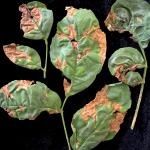 Ash anthracnose, caused by Plagiostoma fraxini (also known as Gnomoniella fraxini), on Japanese ash (Fraxinus longicuspis) and Chinese ash (F. chinensis ssp. rhynchophylla). Both trees are mature, with ages of 50 and 80 years old, respectively. They reside in an arboretum on an east facing slope within a small valley. Both trees are exposed to full sun in loam soils that have moderate to good drainage and are treated for emerald ash borer. Earlier this spring, symptoms consistent with foliar anthracnose were observed throughout the canopies. Specifically, irregular blotches occurring primarily along the leaf margins and primary veins, and foliar distortion. This pattern of foliar distortion and curling is a common symptom of ash anthracnose (see photo showing symptoms on F. longicuspis). The abundant rainfall in April and May facilitated localized outbreaks of anthracnose on deciduous hardwoods. However, the disease has been present on these trees in previous years.
Ash anthracnose, caused by Plagiostoma fraxini (also known as Gnomoniella fraxini), on Japanese ash (Fraxinus longicuspis) and Chinese ash (F. chinensis ssp. rhynchophylla). Both trees are mature, with ages of 50 and 80 years old, respectively. They reside in an arboretum on an east facing slope within a small valley. Both trees are exposed to full sun in loam soils that have moderate to good drainage and are treated for emerald ash borer. Earlier this spring, symptoms consistent with foliar anthracnose were observed throughout the canopies. Specifically, irregular blotches occurring primarily along the leaf margins and primary veins, and foliar distortion. This pattern of foliar distortion and curling is a common symptom of ash anthracnose (see photo showing symptoms on F. longicuspis). The abundant rainfall in April and May facilitated localized outbreaks of anthracnose on deciduous hardwoods. However, the disease has been present on these trees in previous years.
Fire blight (Erwinia amylovora) and secondary stem cankering by Diplodia on a mature quince (Cydonia oblonga). The tree is 40 years old and has been in an arboretum for about 35 years. It resides in full sun with drip irrigation in loam soils that are moderately well-drained. For many years, a shoot tip blight has developed throughout roughly 5–10% of the canopy in late spring to early summer. The submitted shoots and leaves were blackened and the shoot tips were curled downward. Shaving of the bark revealed a dark discoloration of the vascular tissue. Upon microscopic evaluation, to visualize the bacterial streaming from the infected tissues, asexual spores (conidia) of Diplodia were also observed. Secondary colonization by opportunistic cankering fungi after fire blight is very common. This can make identification of the fire blight bacterium (Erwinia) challenging when the symptoms are more nuanced. The disease has remained at relatively low levels without specific treatment, so it’s possible fire blight can be eradicated with targeted intervention.
Phytophthora root rot and small branch cankering caused by Diplodia on white fir (Abies concolor). Numerous trees ranging in age from 4–10 years old at a Christmas tree farm are diseased. The field is on a gently sloping hill in full sun with moderately well-drained, loam soils. Trees are well spaced and appeared healthy in previous years. Symptoms first developed in the lower, wetter portions of the field and have since spread. Symptoms of infection include a general pale green to chlorotic appearance in the canopy with browning needles and shoot dieback in the lower canopy. Over time, needles throughout the entire canopy become brown. The grower submitted the lower trunk, root flare, and primary lateral roots along with symptomatic branches from two trees. The feeder and primary roots showed a brown discoloration of the vascular tissue typical of infection by Phytophthora. Specific testing was positive for the pathogen. The heavy rains and soil saturation in 2023 likely facilitated disease development and spread. Many different native and non-native Phytophthora species are responsible for Phytophthora root rot and all true firs (Abies) are susceptible to infection.
Report by Nick Brazee, Plant Pathologist, UMass Extension Plant Diagnostic Lab, UMass Amherst
Insects and Other Arthropods
The Professional Insect and Mite Management Guide for Woody Plants is freely available at https://ag.umass.edu/insectmiteguide. Please let me know how it is or isn’t working for you by responding to the following Feedback Form: Professional Insect & Mite Management Guide for Woody Plants. Your feedback is valuable and I cannot wait to hear from you!
Note: Our website is undergoing updates, and as such, the collapsible menus on the home page of the Guide are currently not functioning. Thank you for your patience as we await these updates.
Invasive Updates:
- Asian Longhorned Beetle is still present in Worcester, Shrewsbury, Boylston, West Boylston, and parts of Holden and Auburn, MA. If you suspect you’ve found this insect or the damage it causes, please report it to the Asian Longhorned Beetle Eradication Program office in Worcester, MA at 508-852-8090 or toll free at 1-866-702-9938.
Now is the time to monitor for adult Asian longhorned beetles! The USDA APHIS considers August "Tree Check Month", so get out there and look at those maples! When in doubt about the identity of a longhorned beetle, always report it.
To report an Asian longhorned beetle find online or to compare it to common insect look-alikes, visit: http://massnrc.org/pests/albreport.aspx
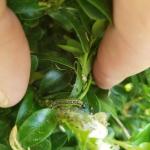
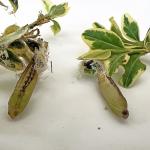

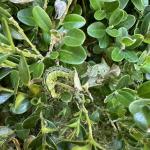 Box Tree Moth has been detected in the following Massachusetts communities: Bourne, Sandwich, and Barnstable. A map of these locations is available at MDAR’s Invasive Pest Dashboard. If you believe you have found this insect, please take a photo, note your location, and report it immediately to the MA Department of Agricultural Resources using their Report a Pest Form. Box tree moth caterpillars were reported to be active at certain locations on Cape Cod, MA as of the week of April 19th. C.L. Fornari reports on 6/8/2024 that box tree moth pupae are present at a location in Sandwich, MA at this time (see photos). These pupae are likely the overwintered caterpillars that were actively feeding in April which will give rise to the next generation of adults.
Box Tree Moth has been detected in the following Massachusetts communities: Bourne, Sandwich, and Barnstable. A map of these locations is available at MDAR’s Invasive Pest Dashboard. If you believe you have found this insect, please take a photo, note your location, and report it immediately to the MA Department of Agricultural Resources using their Report a Pest Form. Box tree moth caterpillars were reported to be active at certain locations on Cape Cod, MA as of the week of April 19th. C.L. Fornari reports on 6/8/2024 that box tree moth pupae are present at a location in Sandwich, MA at this time (see photos). These pupae are likely the overwintered caterpillars that were actively feeding in April which will give rise to the next generation of adults.
Adult box tree moths have been reported arriving at blacklight traps on Cape Cod, MA as of 6/24/2024 and by others monitoring the same area the week prior. A new generation of box tree moth caterpillars for the 2024 season was reported by C.L. Fornari on Cape Cod as of 7/18/2024. It remains important to monitor boxwood for this pest.
The USDA APHIS has announced a new quarantine for box tree moth in Massachusetts and Ohio, and has expanded existing quarantines in Michigan and New York. This includes conditions for interstate movement of regulated Buxus species. This quarantine includes the entire Commonwealth of Massachusetts. The federal order states:
“Boxwood plants may only be moved interstate from a quarantined area from an establishment operating under a compliance agreement, and only if accompanied by a certificate issued by a State Agricultural Authority certifying that the requirements of this Federal Order and the compliance agreement have been met. These requirements will prevent producers and distributors of boxwood from moving infested plants interstate. State Agricultural Authorities may prescribe additional safeguards and protocols.
All other regulated articles of boxwood, including plant parts, pieces, cuttings, clippings, debris, and any portion of the plant, alive or dead, except for decorative purposes, are prohibited from movement.”
MDAR has recently sent a notice to boxwood growers in Massachusetts of the following:
"Effective May 22, 2024, the USDA has issued a Federal Order establishing a quarantine for the entire state of Massachusetts. In an effort to restrict the movement of box tree moth, boxwoods (Buxus spp.) may no longer be exported from Massachusetts except by an establishment operating under a compliance agreement (CA) to be issued by MDAR. Anyone wishing to register for a CA must go to the Massachusetts Department of Agricultural Resources box tree moth page and click on the EXPORTS link, and fill out the form. An MDAR staff person will follow up within one week. Please note that the quarantine does NOT restrict in-state sales, movement within the state, or import of boxwoods into Massachusetts. If you have any further questions, please feel free to contact either MDAR (taryn.lascola@mass.gov) or USDA (203-741-5641)."
To read the full announcement of the box tree moth quarantine for Massachusetts from MDAR, please visit the Massachusetts Introduced Pests Outreach Blog.
Need information about monitoring and trapping box tree moth? Check out this newly available Box Tree Moth Monitoring & Trapping fact sheet from UMass Extension.
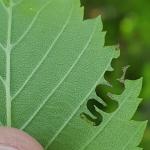
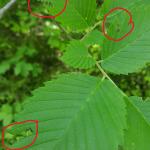 Elm Zigzag Sawfly has been detected in the following Massachusetts communities: Becket, Chester, Windsor, and Williamstown. If you believe you have found this insect, please take a photo, note your location, and report it immediately using MA DCR’s Massachusetts Elm Zigzag Sawfly Reporting Form. Felicia Hubacz, MA DCR, reports elm zigzag sawfly larvae actively feeding in the Becket, MA population as of 5/28/2024. UMass Extension observed tiny elm zigzag sawfly feeding in the Windsor, MA population on 5/31/2024 (see photos).
Elm Zigzag Sawfly has been detected in the following Massachusetts communities: Becket, Chester, Windsor, and Williamstown. If you believe you have found this insect, please take a photo, note your location, and report it immediately using MA DCR’s Massachusetts Elm Zigzag Sawfly Reporting Form. Felicia Hubacz, MA DCR, reports elm zigzag sawfly larvae actively feeding in the Becket, MA population as of 5/28/2024. UMass Extension observed tiny elm zigzag sawfly feeding in the Windsor, MA population on 5/31/2024 (see photos).
Now is the time to search for elm zigzag sawfly larvae actively feeding on their host plants! Please report any suspicious defoliation of elm to the previous reporting link.
- Emerald Ash Borer is well established across most of Massachusetts. A map of these locations from the MA Department of Conservation and Recreation is available.
- Jumping Worms are non-native earthworms that impact natural ecosystems. Available resources include a fact sheet about earthworms in Massachusetts and jumping worm FAQ’s. In August, adult jumping worm sightings typically increase due to the life cycle of these earthworms and their large and noticeable size at this time of year.
- Spotted Lanternfly now has established populations in the following locations in Massachusetts: Holyoke, Springfield, West Springfield, Agawam, Fitchburg, Worcester, Shrewsbury, Southborough, Ashland, Wellesley, Weston, Chelmsford, Grafton, and Lawrence, MA. The MA Department of Agricultural Resources reported that spotted lanternfly egg hatch had begun in Holyoke and Springfield, MA as of 5/14/2024. As of 7/19/2024, MDAR reports mostly 4th instar spotted lanternfly nymphs and a few adult spotted lanternflies active at known populations in the Connecticut River Valley.
In areas of the state where spotted lanternfly is present and has been observed through monitoring, the SLF Management Guide suggests management options for SLF nymphs. Spotted lanternfly should not be managed using insecticides in locations where the insect has not been confirmed in the state. This may result in unnecessary, costly, and environmentally irresponsible applications. The first step in areas outside of the communities listed above for MA is to report SLF to MDAR (also see link below).
If you believe you have found this insect, please take a photo, note your location, and report it immediately using the Spotted Lanternfly Report Form. Available resources include a map of spotted lanternfly locations in Massachusetts from the MA Department of Agricultural Resources, MDAR’s spotted lanternfly fact sheet, UMass Extension’s Spotted Lanternfly Management Guide, and an SLF InsectXaminer episode.
Medically Important Pests:
- Ticks are a serious public health concern and may be active in managed landscapes any time temperatures are above freezing. Encounters with deer ticks can increase in New England in April, October, and November; however, precautions should be taken year-round to prevent tick bite exposure. Available resources include tick information from Cape Cod Cooperative Extension, personal protective measures, and a list of potential tick testing resources. The New England Center of Excellence in Vector-Borne Diseases (NEWVEC) also provides the latest tick information and resources.
- Mosquitoes and the diseases they vector are also a serious public health concern in Massachusetts by summer. Available resources include Mosquito Repellents from the Department of Public Health and Prevent Mosquito Bites from the Centers for Disease Control and Prevention. The Massachusetts Department of Public Health tests for Eastern Equine Encephalitis (EEE) and West Nile Virus (WNV) from June to October. The Massachusetts risk maps are currently available for both EEE and WNV. As of July 1st, EEE has been detected in mosquito samples taken from Carver, MA. The MA Department of Public Health now ranks Carver and surrounding communities at moderate risk (meaning there is EEE in mosquito populations in that area now). On June 25th, WNV was found in mosquito samples taken from Quincy, MA. The MA Department of Public Health ranks all of Massachusetts as low risk for WNV (meaning that they consider infection with WNV unlikely as of 7/9/2024). As of 7/25/2024 there have been 14 EEE positive and 27 WNV positive mosquito samples in MA.
- Wasps/Hornets: Many wasps are predators of other arthropods, including pest insects such as certain caterpillars that feed on trees and shrubs. Adult wasps hunt prey and bring it back to their nest where young are being reared as food for the immature wasps. A common such example are the paper wasps (Polistes spp.) who rear their young on chewed up insects. Paper wasps can sting, and will defend their nests, which are open-celled paper nests that are not covered with a papery “envelope”. These open-celled nests may be seen hanging from eaves or other outdoor building structures. Aerial yellow jackets and hornets create large aerial nests that are covered with a papery shell or “envelope”. Common yellow jacket species include those in the genus Vespula. Dolichovespula maculata is commonly known as the baldfaced hornet, although it is not a true hornet. The European hornet (Vespa crabro) is three times the size of a yellow jacket and may be confused for the northern giant hornet (Vespa mandarinia). The European hornet is known to Massachusetts, but the northern giant hornet is not. If you are concerned that you have found or photographed a northern giant hornet, please report it using the MA Department of Agricultural Resources Report Pest Sightings page. Some people are allergic to stinging insects, so care should be taken around wasp/hornet nests. Unlike the European honeybee (Apis mellifera), wasps and hornets do not have barbed stingers and therefore can sting repeatedly when defending their nests. It is best to avoid them and, if that cannot be done and assistance is needed to remove them, consult a professional.
Tree & Shrub Insect & Mite Pest Suggested Scouting:
- Andromeda Lace Bug is most commonly encountered on Japanese andromeda, however other host plants may be impacted. Most activity from this insect occurs between late May through September, with several generations occurring per year. Both nymphs and adults feed on host plant leaf undersides and cause white/yellow-colored spots or chlorosis to occur on host plant leaf surfaces.
- Arborvitae Leafminer moths appear from mid-June to mid-July and lay their eggs. Eggs hatch and larvae enter the leaves where they feed, often unnoticed until January or February when browned leaf tips become more apparent. Feeding from this insect is sometimes confused for winter injury, and vice versa.
- Azalea Lace Bug is a pest of both deciduous and evergreen azaleas (Rhododendron spp.), however resistance has been reported in Rhododendron atlanticum, R. arborescens, R. canescens, R. periclymenoides, and R. prunifolium. The insects feed on host plant leaf undersides, and cause chlorosis on leaf surfaces. Azalea lace bugs are active throughout the summer.
- Azalea Leafminer larvae mine the leaves of azalea (Rhododendron spp.) causing brown patches in the leaves to appear. Leaves may also be tied together with silken strands. In locations where a second generation is possible, this damage may be very noticeable. Raking up and destroying fallen leaves surrounding plants may help reduce the population on a site.
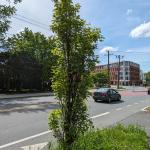

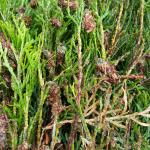 Bagworm caterpillar feeding is underway! A sample of emerald green arborvitae from Hampshire County was submitted to the UMass Plant Diagnostics Laboratory on 7/23/2024, filled with bagworm caterpillars. Browning of foliage was evident from their feeding. A population of this size can easily work its way down a hedge, defoliating the plants as they go. By August, caterpillars and their associated bags will be very large, and the defoliation and feeding damage on host plant leaves they can cause will be quite noticeable by then.
Bagworm caterpillar feeding is underway! A sample of emerald green arborvitae from Hampshire County was submitted to the UMass Plant Diagnostics Laboratory on 7/23/2024, filled with bagworm caterpillars. Browning of foliage was evident from their feeding. A population of this size can easily work its way down a hedge, defoliating the plants as they go. By August, caterpillars and their associated bags will be very large, and the defoliation and feeding damage on host plant leaves they can cause will be quite noticeable by then.- Bronze Birch Borer adults emerge from susceptible host plants in early mid-June. Mating and egg laying will occur, and eggs will be laid singly or in groups on host plant bark. Eggs hatch and larvae bore beneath the bark to feed. European white birch (Betula pendula) and Himalayan birch (Betula jacquemontii) are preferred host plants.
- Cryptomeria Scale first generation crawlers are present from approximately 600-800 GDD's and second generation crawlers are present from 1750-2130 GDD's. Look for discolored needles on susceptible host plants. Check the undersides of needles for the hardened scale covers and/or yellow crawlers. Crawlers present in June and August. Scout for scale insects on the underside of needles on the inside of bottom branches first. Scouting on overcast days may make it easier to see the symptoms caused by cryptomeria scale infestation. Yellow sticky cards can be placed in infested trees to aid in scouting for adult (winged) male emergence. Egg laying will begin soon after males are seen. Check scale covers for round exit holes left behind by natural enemies.
- Dogwood Borer is a species of clearwing moth whose larvae bore not only into dogwood (Cornus), but hosts also include flowering cherry, chestnut, apple, mountain ash, hickory, pecan, willow, birch, bayberry, oak, hazel, myrtle, and others. Kousa dogwood appears to be resistant to this species. Signs include the sloughing of loose bark, brown frass, particularly near bark cracks and wounds, dead branches, and adventitious growth. The timing of adult emergence can be expected when dogwood flower petals are dropping and weigela begins to bloom. Adult moth flights continue from then until September.
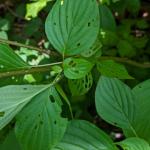
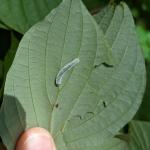 Dogwood Sawfly larvae feed on the foliage of dogwood. Dogwood sawflies are not susceptible to Btk (Bacillus thuringiensis Kurstaki) however, spinosad should be effective on young dogwood sawfly larvae.
Dogwood Sawfly larvae feed on the foliage of dogwood. Dogwood sawflies are not susceptible to Btk (Bacillus thuringiensis Kurstaki) however, spinosad should be effective on young dogwood sawfly larvae.- Dusky Birch Sawfly second generation larvae may be present on various species of birch (Betula) at this time. Second generation adults may emerge by mid-July, laying eggs which will hatch and feeding larvae may be present until mid-September. While small trees may be defoliated by these feeding Hymenopteran caterpillars, in the majority of cases feeding by this insect rarely reaches levels where chemical intervention is necessary. Btk (Bacillus thuringiensis kurstaki) does not work on sawfly larvae.
- Euonymus Scale overwinters as a fertilized female. Eggs are laid beneath dark brown female scale covers in the early spring. Egg hatch occurs over a 2-3 week period, with crawlers present by early June. A second generation of crawlers may be present by mid-July, with adults present again in August and September. While Euonymus spp. host plants are preferred, additional host plants have been reported.
- Fall Webworm eggs may hatch by late June or early July, depending on local conditions. Young larvae begin feeding in groups, and eventually cover entire branches with webbing as they mature. This native insect can typically coexist with its host plants. If webs cannot be tolerated on ornamental trees or shrubs, monitor for them on the tips of branches when they are still small, and prune out and remove.
- Hemlock Looper collectively refers to two species of geometrid (inchworm; looper) caterpillars. Overwintered eggs hatch by late May or early June, at which time young larvae begin their messy feeding on host plant needles. Hemlock and balsam fir are preferred hosts. Hemlock looper caterpillars mature slowly, and may not begin pupation until late July with adults emerging by September and October.
- Imported Willow Leaf Beetle adults overwinter in loose bark or other sheltered areas near susceptible Salix and Populus spp. host plants. Once the host plant leaves emerge in the spring, adults will begin to feed and lay tiny, yellow eggs in clusters on leaf undersides. Additional resources include an InsectXaminer episode about imported willow leaf beetle. Feeding damage by this insect is very apparent currently on susceptible host plant leaves.
- Japanese Beetle adults have been reported active at the end of June in MA in 2024 (see scouting reports above). Adult beetles skeletonize the leaves of susceptible host plants, often feeding on roses, grapes, and shrubs first and moving to the foliage of trees as the season continues. Adults are typically active from late June to early August.
-
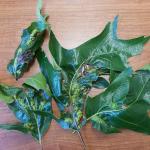
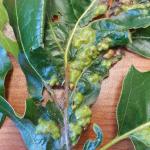 Oak Leaf Blister Gall occurs most often on the leaves of red oak, as shown in these photos. (This sample was submitted to the UMass Plant Diagnostics Lab from Essex County, MA.) The cynipid gall wasp Melikaiella ostensackeni creates gall structures that appear as irregular and very hard protrusions on the upper leaf surface and corresponding lumpy, puckered areas on the lower surface. Slicing open the galls will reveal individual wasp larvae, pupae, or adults. As the galls “mature,” they turn from light green to brown and are peppered with wasp emergence holes as the adult wasps leave the galls. This typically occurs in mid-to-late summer. This species of gall wasp and the corresponding injury it causes to red oak is not significant for the overall health of the tree and does not require management. Other organisms may cause similar distortion to red oak leaves.
Oak Leaf Blister Gall occurs most often on the leaves of red oak, as shown in these photos. (This sample was submitted to the UMass Plant Diagnostics Lab from Essex County, MA.) The cynipid gall wasp Melikaiella ostensackeni creates gall structures that appear as irregular and very hard protrusions on the upper leaf surface and corresponding lumpy, puckered areas on the lower surface. Slicing open the galls will reveal individual wasp larvae, pupae, or adults. As the galls “mature,” they turn from light green to brown and are peppered with wasp emergence holes as the adult wasps leave the galls. This typically occurs in mid-to-late summer. This species of gall wasp and the corresponding injury it causes to red oak is not significant for the overall health of the tree and does not require management. Other organisms may cause similar distortion to red oak leaves. -

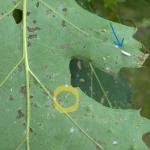
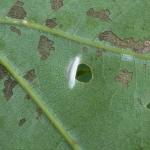 Oak Skeletonizer populations have been noticeable in forested locations in the Williamsburg, MA area in recent years. A park tree in Ashfield, MA showed signs of the activity of this insect on 7/6/2024 as shown here. The oak skeletonizer is a native species of New England and elsewhere in the eastern United States and parts of Canada. Deciduous oaks and chestnut are hosts for this insect. Occasionally, this insect has a large outbreak population. For example, in 1971 in New York, trees were damaged by this insect by July and a second generation was found by September. In 1959 and 1960, two generations per year were observed in Michigan (Gibbons and Butcher, 1961).
Oak Skeletonizer populations have been noticeable in forested locations in the Williamsburg, MA area in recent years. A park tree in Ashfield, MA showed signs of the activity of this insect on 7/6/2024 as shown here. The oak skeletonizer is a native species of New England and elsewhere in the eastern United States and parts of Canada. Deciduous oaks and chestnut are hosts for this insect. Occasionally, this insect has a large outbreak population. For example, in 1971 in New York, trees were damaged by this insect by July and a second generation was found by September. In 1959 and 1960, two generations per year were observed in Michigan (Gibbons and Butcher, 1961).Foliage of the red oak group is skeletonized by this species. Leaves become translucent and eventually dry out. Heavily attacked foliage will appear lacey from the skeletonizing. Occasional outbreaks can cause damage over a large area, and repeated years of defoliation can cause a reduction in host plant growth. Occasionally, part of the tree crown may be killed by the activity of this insect. However, the oak skeletonizer is often found in low level, non-damaging populations and their presence can be tolerated.
Visually monitor for the activity of this insect in late May or early June (first generation). Look for skeletonized host plant leaves and eventually the characteristic white, ribbed cocoons. Trees can tolerate this native insect and often chemical management is not necessary.
-
Obscure Scale may be present on oak, chestnut, hickory, or pecan. Newly hatched crawlers may be active on infested stems and branches for a long period of time, roughly between mid-July through September. Because the scale coverings, even of dead scales, cling to the host plant bark, heavy infestations that have been present for multiple years may be detected any time of the year if the layered, encrusted scales are searched for. Take note if branches appear deformed or lumpy/misshapen.
- Oriental Beetle adults are active from mid-June through early August in Massachusetts. Adult activity occurs in the evening and at night, so the feeding they do on certain flowers (daisy, roses, phlox, and petunia) may not be seen by the observer.
- Pine Needle Scale can be a very serious pest of the needles of ornamental pines. Light infestations may go unnoticed and typically do not cause considerable damage. As a population increases, this scale insect feeds with piercing-sucking mouthparts to remove host plant fluids from the needles, causing them to eventually turn yellowish in color and possibly brown. Twigs and entire branches may eventually be killed. Lower branches typically die first. Depending upon geographic location, one or two generations of pine needle scales occur per year. If a second generation is present, second-generation crawlers are present by late July through September. Two generations per year occur in Massachusetts. More northerly locations may have a single generation per year.
- Pitch Mass Borer overwinters in the pitch mass found on the host plant. This insect tunnels beneath the bark, into the cambium. It may take up to two years for the pitch mass borer to mature. Pupation typically occurs by the end of May through June, in time for adult clearwing moth emergence in July and August.
- Privet Thrips are a non-native insect pest of privet, lilac, and ash. Thrips feed on the leaves of privet, causing them to appear gray in color made up of chlorotic spots. Immature thrips may be viewed with magnification on the undersides of host plant leaves. Several generations per year may be possible throughout the summer.
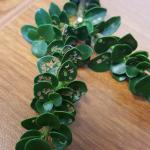
 Redheaded Flea Beetle (Systena frontalis) has been identified as a native pest of nurseries in many locations in the eastern United States. Suspected redheaded flea beetle damage was seen on Ilex crenata 'Dwarf Pagoda' (Dwarf Pagoda Japanese holly) on 3/27/2024 that was purchased in Massachusetts but may have originated in NJ. While identification of this species of insect is uncertain based on host plant damage alone, it appears to be a reasonable and educated assumption. Redheaded flea beetles are known to feed on a wide variety of host plants. These include but are not limited to: cabbage, beans, beets, blueberries, and other agricultural crops as well as Physocarpus, Weigelia, Cornus, Forsythia, Itea, Hydrangea, and Ilex. Adult beetles are active and feed from approximately late-June to mid-September on the upper and lower leaf surfaces of their hosts. This can cause damage that looks like skeletonization and eventually holes in the leaves. Leaves appear covered in brown patches as in these photos. This damage was caused last season on this evergreen plant.
Redheaded Flea Beetle (Systena frontalis) has been identified as a native pest of nurseries in many locations in the eastern United States. Suspected redheaded flea beetle damage was seen on Ilex crenata 'Dwarf Pagoda' (Dwarf Pagoda Japanese holly) on 3/27/2024 that was purchased in Massachusetts but may have originated in NJ. While identification of this species of insect is uncertain based on host plant damage alone, it appears to be a reasonable and educated assumption. Redheaded flea beetles are known to feed on a wide variety of host plants. These include but are not limited to: cabbage, beans, beets, blueberries, and other agricultural crops as well as Physocarpus, Weigelia, Cornus, Forsythia, Itea, Hydrangea, and Ilex. Adult beetles are active and feed from approximately late-June to mid-September on the upper and lower leaf surfaces of their hosts. This can cause damage that looks like skeletonization and eventually holes in the leaves. Leaves appear covered in brown patches as in these photos. This damage was caused last season on this evergreen plant.- Redheaded Pine Sawfly larvae feed on the outside of host plant needles. This results in shriveled, browned, and straw-like needles that remain attached to the hosts. Older caterpillars are capable of eating the entire needle. Feeding began in the spring and early summer, and can sometimes be extensive by the fall.
- Southern Pine Beetle has been trapped in Massachusetts since 2015. By 2022 and 2023, southern pine beetle has reached outbreak conditions in small areas of the state, killing pitch pine (Pinus rigida). (Particularly on Martha’s Vineyard and Nantucket islands in MA.) If you believe you have found infested pitch pine in Massachusetts, please report southern pine beetle using the Massachusetts Southern Pine Beetle Reporting Form from MA DCR.
-
Tuliptree Aphid is a native North American insect that occurs wherever the tuliptree grows. Depending upon local temperatures, these aphids may be present from mid-June through early fall. There are several generations per year. The tuliptree aphid can cause reduced leaf size as a result of its feeding. These insects feed on their host plants with piercing-sucking mouthparts which they use to remove host plant fluids. Some leaves, especially those in the outer canopy, may turn brown or yellow and drop from infested trees prematurely.
The most significant impact these aphids can have is typically the resulting honeydew, or sugary liquid excrement, which may be present in excessive amounts and coat leaves and branches, leading to sooty mold growth. This honeydew may also make a mess of anything beneath the tree, including sidewalks and parked cars. Ants, bees, wasps, and flies may be attracted to and feed on the honeydew. Management is typically not necessary, as this insect does not significantly impact the overall health of its host.
- Twospotted Spider Mite season is under way as warm temperatures rise! Populations on many different deciduous and some coniferous hosts may rise from 363-618 GDD's and again from 1300-2000 GDD's. Twospotted spider mites prefer hot, dry conditions in the summer and fall. Population increases and subsequent plant damage can occur under these conditions. Using piercing-sucking mouthparts, mites feed primarily on the underside of host plant leaves and remove fluids. This feeding causes graying or yellowing of the leaves. Necrotic spots can also occur in advanced stages of leaf damage. This may lead to a stippled/bleached appearance of leaves; on occasion, complete defoliation due to spider mite activity is possible under high populations. Twospotted spider mites also create a fine webbing which can be found on infested plants.
Magnification is needed to visually detect twospotted spider mites. At least a 10-15X hand lens is required. The undersides of host plant leaves can be examined for the mites themselves or their shed or cast skins, as well as the fine webbing left behind by spider mites. However, it may be easier to view twospotted spider mites when a branch that is suspected to be infested is shaken or struck over a white piece of paper. See previous link for more details.
- Viburnum Leaf Beetle larvae may be found anywhere on the leaves and usually in groups. When young, larvae feed on the undersides of the leaves. As they grow larger, they may feed on the upper surface. Larval development may take approximately 8-10 weeks to complete and 3 larval instars are reported. Pupae are yellowish and are found in the soil beneath the host plant. Adults emerge around the middle of July and are brown, smaller than the largest larvae (approximately ¼ inch), and will also feed on the leaves. Adults are present in the landscape until the first hard frost.
- White Prunicola Scale is an armored scale that has been on occasion found in samples submitted to the UMass Plant Diagnostics Laboratory. Trunks and branches primarily of Japanese flowering cherry, lilac, and privet are infested by the white prunicola scale. Feeding may reduce tree vigor and foliage may yellow or become sparse. Two generations may occur per year in New England, with eggs/crawlers in early June and again in early August. However, under warmer conditions, three generations per year are possible.
- Yellow Poplar Weevil is also known as the sassafrass weevil, the magnolia leafminer, or the tulip tree leafminer. This insect, as all of these common names suggest, feeds on yellow poplar (tulip tree; Liriodendron tulipifera), sassafras (Sassafras albidum), magnolia (Magnolia spp.), as well as bay laurel (Laurus nobilis). Adult beetles lay eggs in the midribs of host plant leaves by May, after which the eggs hatch and larvae feed by creating blotch mines in the leaves. Larvae can be observed in May and June, and adults emerging to feed again by August, prior to overwintering in sheltered areas.
Beneficials/Non-Pests:
- Reduviidae or the assassin bugs or ambush bugs are common predaceous hunters of other insects, including common pests. Their thickened front pair of legs can be used to capture and grasp prey. Both adults and immatures are active hunters. They have piercing-sucking mouthparts, but do not use them to feed on plants! They should be preserved and encouraged in managed landscapes – but not touched. They will defend themselves with those piercing-sucking mouthparts.
Report by Tawny Simisky, Extension Entomologist, UMass Extension Landscape, Nursery & Urban Forestry Program
Landscape Weeds
For information about identification of weeds noted below, check out UMass Extension's Weed Herbarium.
Crabgrass (and other annual grassy weed) management in turf: Recent rainfall and hot warm weather is moving crabgrass along and you need to bring your “A Game.” Postemergence herbicides will effectively manage crabgrass and routine monitoring of turf areas is required to properly select the appropriate postemergence herbicide. Currently, crabgrass in New England is in the 3 to 6 tiller stage of growth. Determination of the predominant growth stage will dictate herbicide selection (see table below). Observations from turf professionals describe 2024 as a banner year for crabgrass. There are a few contributing factors that we should explore to understand why crabgrass and other annual grasses have been "out of control" this season.
- Some preemergence herbicides applied in 2023 may not have performed as well as expected expect due to dry conditions in the spring of 2023. For good preemergence control, these products must be sufficiently watered in via rainfall or irrigation.
- For areas where preemergence applications were not effective last year, a postemergence annual grass herbicide should have been applied to catch escapes. The latter part of the 2023 season was exceptionally rainy, which made these postemergence herbicide applications difficult or impossible to complete.
- The resulting poor crabgrass control of 2023 resulted in seeds being added to the weed seed bank. This surface seed was ready to go in 2024.
- New England has been very wet during the 2024 season. Moist and warm soils have increased rates of microbial activity. Microbial degradation is the most common method by which herbicides degrade. As an herbicide degrades, its ability to control weeds decreases. A reduction in preemergence control should be addressed with a postemergence application to provide effective control.
- Preemergence herbicide applications for crabgrass and annual grass control should be applied when Forsythia in the area is in full bloom before the beginning of flower drop. In New England, this application window is from mid to late April to very early May. Applications made in March will fall off as the herbicide often degrades before the annual grasses germinate. When it comes, correct preemergence timing remember “early down, early gone.
Postemergence herbicides for crabgrass control |
||||||
|---|---|---|---|---|---|---|
|
Postemergence Herbicide |
Crabgrass Growth Stage LF = leaf, TL = tiller |
|||||
|
1- to 5-LF |
1-TL |
2-TL |
3-TL |
4-TL |
5-TL & up |
|
|
dithiopyr |
YES |
YES |
YES |
YES |
NO |
NO |
|
mesotrione |
YES |
YES |
YES |
YES |
NO |
NO |
|
quinclorac |
YES |
YES |
NO |
NO |
NO |
YES |
|
fenoxaprop |
YES |
YES |
NO |
NO |
NO |
NO |
English ivy (Hedera helix): In the last few of weeks, I have received a couple of inquiries about whether English ivy (Hedera helix) is invasive in Massachusetts. These inquiries also ask about the best way to control English ivy. The Massachusetts Invasive Plant Advisory Committee (MIPAG) has not evaluated English ivy for invasiveness in Massachusetts. While this species is non-native, it would likely fall short of meeting some of the criteria that would make it designated as invasive, likely invasive, or potentially invasive. A full evaluation of this species would not likely show this plant to 1) demonstrate the potential for rapid and widespread dispersion and establishment, 2) have the potential to disperse over spatial gaps, and 3) exist in high numbers in natural plant communities and minimally managed habitats. MIPAG defines an invasive plant as a non-native species that can spread into native or minimally managed plant systems in Massachusetts. These plants cause economic or environmental harm by developing self-sustaining populations and becoming dominant and/or disruptive to those systems. Early during the evaluation of a plant species, a well-known nurseryman in Massachusetts coined the phrase “garden thug” which appropriately describes this plant species' behavior in New England. Management of a “garden thug” certainly can be justified in some situations. Initial research done in eastern Europe and repeated by Joe Neal at North Carolina State University showed that effective control was achieved with a postemergence application of glyphosate in the spring. Applications of a 41% glyphosate formulation at 4 to 5% should be applied when the new-season growth is 3 to 5 inches long and has 3 to 5 leaves. At least 2 or 3 years of a spring application will likely be required for complete control.
Japanese knotweed (Fallopia japonica): Do not attempt to control Japanese knotweed now, as herbicide applications are not effective in the early part of the growing season. In preparation for a late season herbicide application, stand of knotweed should have been mowed to the ground in late May and early June. This practice facilitates later herbicide application by removing the dried stems from the previous year’s growth and will control plant height to make herbicide treatment easier in late summer. Removal of new top grow can reduce the plant’s carbohydrate reserves with this early season mowing. Since knotweed commonly grows in wet areas or near streams, rivers or wetlands the management of this invasive plant may invoke 310 CMR 10.00: the Massachusetts Wetlands Protection Act. 310 CMR 10.00 regulates all activities in the resource areas identified in the act. Before any management activities can begin, the Conservation Commission in the municipality should be contacted to determine to what extent 310 CMR 10.00 might impact the project. Since we are quickly approaching the herbicide treatment window, now is the time to start working with the local Conservation Commissions so that work can proceed in a timely manner.
Report by Randy Prostak, Weed Specialist, UMass Extension Landscape, Nursery, and Urban Forestry Program
Additional Resources
Pesticide License Exams by the MA Dept. of Agricultural Resources (MDAR) are now held online. For more information and how to register, go to: https://www.mass.gov/pesticide-examination-and-licensing.
To receive immediate notification when the next Landscape Message update is posted, join our e-mail list or follow us on Facebook.
For a complete listing of landscape, nursery, and urban forestry program upcoming events, see our calendar at https://ag.umass.edu/landscape/upcoming-events.
For commercial growers of greenhouse crops and flowers - Check out UMass Extension's Greenhouse Update website.
For professional turf managers - Check out our Turf Management Updates.
For home gardeners and garden retailers - Check out our home lawn and garden resources.
Diagnostic Services
UMass Laboratory Diagnoses Landscape and Turf Problems - The UMass Extension Plant Diagnostic Lab is available to serve commercial landscape contractors, turf managers, arborists, nurseries and other green industry professionals. It provides woody plant and turf disease analysis, woody plant and turf insect identification, turfgrass identification, weed identification, and offers a report of pest management strategies that are research based, economically sound and environmentally appropriate for the situation. Accurate diagnosis for a turf or landscape problem can often eliminate or reduce the need for pesticide use. For sampling procedures, detailed submission instructions and a list of fees, see the Plant Diagnostic Laboratory web site.
Soil and Plant Nutrient Testing - The University of Massachusetts Soil and Plant Nutrient Testing Laboratory is located on the campus of the University of Massachusetts at Amherst. Testing services are available to all. The lab provides test results and recommendations that lead to the wise and economical use of soils and soil amendments. For more information, including current turn-around times, visit the UMass Soil and Plant Nutrient Testing Laboratory web site. The lab is currently accepting orders for Routine Soil Analysis (including optional Organic Matter, Soluble Salts, and Nitrate testing), Particle Size Analysis, Pre-Sidedress Nitrate (PSNT), Total Sorbed Metals, and Soilless Media (no other types of soil analyses available at this time). Check for current turnaround time. Please plan for the fact that date of receipt in the lab is affected by weekends, holidays, shipping time, and time for UMass Campus Mail to deliver samples to the lab.
Tick Testing - The UMass Center for Agriculture, Food, and the Environment provides a list of potential tick identification and testing options at https://ag.umass.edu/resources/tick-testing-resources.
Acknowledgements: UMass Extension gratefully acknowledges the support of the following funding sources for the production of the Landscape Message –
- The Massachusetts Nursery and Landscape Association Fund
- The Massachusetts Department of Conservation and Recreation, Award #ISADCR28219926UMA24A
- Stakeholders like you! The Landscape Message is partially supported by educational program user fees.


